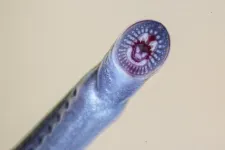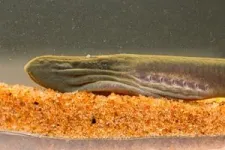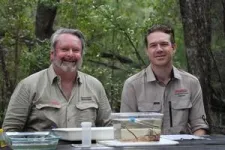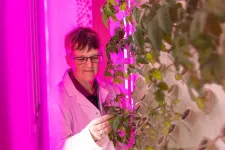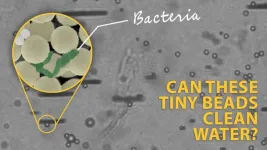(Press-News.org) The Australian brook lamprey (Mordacia praecox) is part of a group of primitive jawless fish. It’s up to 15 cm long, with rows of sharp teeth. Surprisingly, it doesn’t use these teeth to suck blood like most lamprey species – it’s non-parasitic.
As larvae, the Australian brook lamprey lives buried in the bottom of streams for around three years, filter-feeding. Its adult phase is about one year long, in which it doesn’t feed at all. Prior to this study – funded in part by the Australian Government through the National Environmental Science Program’s (NESP) Resilient Landscapes Hub – the species was widely believed to only live in a few streams along a 170 km stretch of coastline near the NSW/Victoria border.
The study began after another exciting discovery: Dr Luke Carpenter-Bundhoo from the Australian Rivers Institute at Griffith University found the species living in streams on K’gari (Fraser Island). To unravel the mystery of Queensland lampreys, Dr Carpenter-Bundhoo teamed up with David Moffatt from DESI, who had found isolated populations of lamprey in other Queensland streams.
Together, they confirmed reports of Australian brook lamprey in Queensland, including as far north as Rockhampton! With this enormous extension of its geographic range, Australian brook lamprey becomes the only lamprey species in the world to live in truly tropical waters.
“It’s quite exciting to find an Endangered species so far out of its known range, yet so close to populated areas. We expect these animals naturally occur in Queensland, and have been here for an awfully long time, but have remained hidden due to their cryptic nature,” said Mr Moffatt.
The Australian brook lamprey is thought to be extinct where it was first described, in southern NSW. Its existence is thought to be threatened by sedimentation, wildfires, and human developments.
Perhaps the biggest threat to their conservation is that they’re very difficult to identify – this species truly faces a case of mistaken identity. For most of their life, the non-parasitic Australian brook lamprey is indistinguishable from its more common blood-sucking southern relative, the short-headed lamprey (Mordacia mordax), which has a conservation status of ‘Least Concern’.
Add to this the fact that, globally, only a few people can tell them apart.
In their new Endangered Species Research article, Dr Carpenter-Bundhoo and Mr Moffatt outline the difficulties of implementing a conservation strategy for this fish and propose some solutions.
The species’ conservation is especially important, given projected sea levels rises mean that many of the lowland freshwater coastal streams where Australian brook lamprey live are likely to become saltwater.
With these new findings, scientists will be better equipped to conserve this unusual and Endangered species.
The surveys were partially funded by a NESP project which aims to restore ecosystem health in the Moonaboola (Mary River) catchment area of south-east Queensland and protect threatened species like the Australian lungfish, the Mary River cod and the giant barred frog.
END
Scientists find ancient, endangered lamprey fish in Queensland, 1400 km north of its previous known range
2024-05-08
ELSE PRESS RELEASES FROM THIS DATE:
New $3.7m climate crop lab will create food for ‘tomorrow’s atmosphere today’
2024-05-08
A unique $3.7m plant lab will put researchers on the frontline in the fight against climate change and create crops for “tomorrow’s atmosphere today”.
The new flagship facility at the University of Essex will allow scientists to adapt plants for a hotter drier planet as food security is increasingly threatened.
It boasts a cutting-edge commercially standard vertical farm, an indoor field that replicates real environments anywhere in the globe, and suites that imitate a warming world – with researchers able to raise CO2 concentration and temperature levels at will.
Computer ...
New air-breathing spacecraft to provide better Earth observation and quicker communications
2024-05-08
Scientists at the University of Surrey are developing a new way to power low-orbit spacecraft using – literally – thin air.
Surrey Space Centre aims to enable extremely low-altitude spacecraft orbits in the upper atmosphere, thanks to funding from the UK Space Agency.
This new spacecraft concept could offer new capabilities in Earth observation, climate monitoring and satellite communications.
Dr Andrea Lucca Fabris, principal investigator from Surrey Space Centre and an electric propulsion specialist, said:
“There are benefits to flying in very low altitude orbits, like being able to operate Earth observation at much ...
Exploring the asteroid apophis with small satellites
2024-05-08
The author of a disaster novel couldn't have dreamed it up any better: On a Friday, the thirteenth of all days, the potentially dangerous asteroid (99942) Apophis will come extremely close to humanity. On 13 April 2029, there will only be around 30,000 kilometres between the cosmic rock and Earth. It will then be possible to see Apophis with the naked eye as a point of light in the evening sky, even from Würzburg.
What makes the asteroid so dangerous: its average diameter is an impressive 340 metres. If it were to hit the Earth, the ...
Research warns of hazardous health risks from flavored vapes
2024-05-08
Research warns of hazardous health risks from flavoured vapes
Research predicts the potential formation of 127 acutely toxic chemicals in flavoured vapes
Findings underscore the urgent need for comprehensive regulation of vaping products
Wednesday, 8 May 2024: New research has uncovered the potentially harmful substances that are produced when e-liquids in vaping devices are heated for inhalation. The study, published in Scientific Reports, highlights the urgent need for public health policies concerning flavoured vapes.
The research team at RCSI University of Medicine and Health Sciences, Dublin, used artificial ...
FAU researchers receive $1M in FDOH grants to fight Alzheimer’s disease
2024-05-08
Three Florida Atlantic University researchers at the forefront of Alzheimer’s disease (AD) research have each received a $350,000 grant from the Florida Department of Health’s “Ed and Ethel Moore Alzheimer’s Disease Research Program.”
The Ed and Ethel Moore Alzheimer’s Disease Research Program was established to improve the health of Floridians by stimulating research into the prevention, diagnosis, treatment, care management and cure of AD.
Florida has the second highest incidence of AD in the nation with 580,000 people ages 65 and ...
Swarms of miniature robots clean up microplastics and microbes, simultaneously (video)
2024-05-08
When old food packaging, discarded children’s toys and other mismanaged plastic waste break down into microplastics, they become even harder to clean up from oceans and waterways. These tiny bits of plastic also attract bacteria, including those that cause disease. In a study in ACS Nano, researchers describe swarms of microscale robots (microrobots) that captured bits of plastic and bacteria from water. Afterward, the bots were decontaminated and reused. Watch a video of them swarming.
The size ...
Where wildlife is welcome
2024-05-08
How do city residents feel about animals in their immediate surroundings? A recent study by the Technical University of Munich (TUM), the University of Jena and the Vienna University of Technology shows how different the acceptance of various wild animals in urban areas is. Important factors are the places where the animals are found and their level of popularity - squirrels and ladybugs come out on top here. The results have important implications for urban planning and nature conservation.
The relationship between city inhabitants and urban animals is complex, ...
THC lingers in breastmilk with no clear peak point
2024-05-08
PULLMAN, Wash. – When breastfeeding mothers in a recent study used cannabis, its psychoactive component THC showed up in the milk they produced. The Washington State University-led research also found that, unlike alcohol, when THC was detected in milk there was no consistent time when its concentration peaked and started to decline.
Importantly, the researchers discovered that the amount of THC they detected in milk was low – they estimated that infants received an average of 0.07 mg of THC per day. For comparison, a common low-dose edible contains 2 mg of THC. The research team stressed that it is unknown whether this amount has any impact ...
An AI leap into chemical synthesis
2024-05-08
Chemistry, with its intricate processes and vast potential for innovation, has always been a challenge for automation. Traditional computational tools, despite their advanced capabilities, often remain underutilized due to their complexity and the specialized knowledge required to operate them.
Now, researchers with the group of Philippe Schwaller at EPFL, have developed ChemCrow, an AI that integrates 18 expertly designed tools, enabling it to navigate and perform tasks within chemical research with unprecedented efficiency. “You might wonder why a crow?” asks Schwaller. “Because ...
U of T researchers lead discovery of natural compounds that selectively kill parasites
2024-05-08
An international team led by researchers at the University of Toronto has found a family of natural compounds with potential as new and more effective treatments for parasitic worms. The compounds stall the unique metabolic process that worms use to survive in the human gut.
Parasitic worms transmitted through soil wreak havoc in developing countries in the tropics. Infection by these parasites leads to malaise, weakness, malnutrition and other debilitating symptoms, and can cause developmental defects in children and impair their growth.
“Soil-transmitted parasitic worms infect over one billion people around the world, typically in low-income communities of developing countries ...
